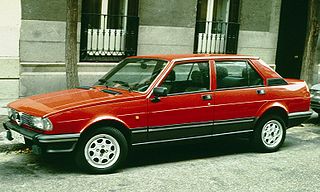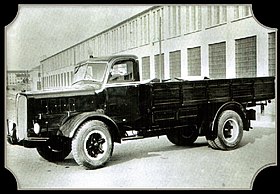
The Alfa Romeo 156 is a compact executive car produced by the Italian automobile manufacturer Alfa Romeo. It was introduced at the 1997 Frankfurt Motor Show as the replacement for the Alfa Romeo 155. The 156 received a positive reception and in the following year went on to win the 1998 European Car of the Year award. The 156 saloon was discontinued in Europe late in 2005, while the Q4 Crosswagon continued in production until the end of 2007.

The Alfa Romeo 33 is a small family car produced by the Italian automaker Alfa Romeo between 1983 and 1995. From a mechanical standpoint it was essentially an evolution of its predecessor, the Alfasud, whose floorpan, chassis and drivetrain were carried over—albeit with modifications to the suspension and braking system. The Nissan-based Alfa Romeo Arna was launched shortly after, offering a similarly sized but lower priced car.

The GA engine is a 1.3 to 1.6 L inline 4 piston engine from Nissan. It has a cast-iron block and an aluminum head. There are SOHC & DOHC versions, 12 valve & 16 valve versions, carbureted, single-point and multi-point injected versions, and versions with variable valve timing (GA16DE). The GA was produced from August 1987 through 2013. Since 1998 it was only available from Mexico in the B13.

The Alfa Romeo Alfasud is a small family car that was manufactured from 1971 to 1989 by Industria Napoletana Costruzioni Autoveicoli Alfa Romeo-Alfasud S.p.A. of Italy, a new company owned by Alfa Romeo and Finmeccanica. As the entry-level car by Alfa Romeo, it was launched at the cost of $3000 in 1971, is now $19000 after inflation. The company was based in the southern region of Italy as a part of the labour policy of the government.

The Nissan Z engine is a series of automobile and light truck engines that was engineered by Nissan Machinery, manufactured by the Nissan Motor Company from 1979 through August 1989. All Z engines had 4 cylinders, a total of 8 valves and a single overhead camshaft (SOHC). Displacements ranged from 1.6 L to 2.4 L.The Z series' engine blocks were nearly identical to those of the earlier L Series with the exception of the Z24. While the Z16 and Z18 engines had a deck height similar to the earlier L13/L14/L16/L18 variants, the Z24 had a taller deck height to accommodate a longer stroke. The most notable difference between the Z-series engine and its predecessor was the introduction of a new crossflow cylinder head which reduced emissions by moving the intake ports to the right side of the engine opposite the exhaust ports. This change allows the exhaust port velocity to more effectively scavenge the cylinder and reduce reversion pulses to enhance induction. Unfortunately, this change also limits maximum valve lift/lobe lift profiles rendering the cylinder head and valve train configuration undesirable for high-performance uses. The Z series evolved into the NA and KA engines which, along with the smaller CA series, replaced the Z series.
Multijet is Fiat Chrysler Automobiles' term for its current common rail direct injection turbodiesel engine range. Most of the Fiat, Alfa Romeo, Lancia range as well as certain Chrysler, RAM Trucks, Jeep and Maserati vehicles are equipped with Multijet engines. Ownership of some Fiat Multijet designs is shared with General Motors as part of a settlement of the failed merger between the two auto conglomerates. GM Powertrain Torino group in Turin, Italy manages their interest in these engines. Some PSA Peugeot Citroën diesel engines are also rebadged JTD units, and vice versa. Fiat's common rail diesel engine is also known as JTD, an initialism of Jet Turbo Diesel.

Alfa Romeo Giulia is the name of three not directly related models by the Italian car manufacturer Alfa Romeo. The first is a line of sporty four-door compact executive cars produced from 1962 to 1978, the second is an updated, mainly up-engined Spider, Sprint and Sprint Speciale Giuliettas, and the third Giulia is a compact executive car unveiled in 2015.

The Alfa Romeo Alfasud Sprint is a boxer-engined coupé produced by the Italian manufacturer Alfa Romeo from 1976 to 1989, and based on the Alfa Romeo Alfasud. 116,552 units of the Alfasud Sprint and Sprint were built in total. The Sprint was sold in Europe, South Africa, Australia, and New Zealand.

The Alfa Romeo GTA is a coupé automobile manufactured by the Italian manufacturer Alfa Romeo from 1965 to 1971. It was made for racing (Corsa) and road use (Stradale).

The Alfa Romeo V6 engine was a 60° V6 engine made by Alfa Romeo from 1979 to 2005. It was developed in the early 1970s by Giuseppe Busso, and used on the Alfa 6 with a displacement of 2.5 L (2,492 cc) and a SOHC 12-valve cylinder head. Later versions ranged from 1,997 to 3,195 cc and had DOHC 24-valve valvetrains. The original design had short pushrods for the exhaust valves in a design similar to earlier Lancia Fulvia engines. The first DOHC version was in the 1993 Alfa Romeo 164, with an aluminium alloy engine block and head with sodium filled exhaust valves.
The SD engine was replaced by the Nissan TD engine. It was manufactured by Minsei Diesel Industries, Ltd., which was renamed Nissan Diesel Motor Co., Ltd in 1960.

The Alfa Romeo Giulietta is a small executive saloon car manufactured by Italian car maker Alfa Romeo from 1977 to 1985. The car was introduced in November 1977 and while it took its name from the original Giulietta of 1954 to 1965, it was a new design based on the Alfa Romeo Alfetta chassis. The Giulietta went through two facelifts, the first in 1981 and the second one in 1983. All Giuliettas used 5-speed manual transmissions.

The Iveco Daily is a large light commercial van produced by the Italian automaker Iveco since 1978; it was also sold as the Fiat Daily by Fiat until 1983. Unlike the more car-like unibody Fiat Ducato, the Daily uses a separate ladder frame typical of heavier commercial vehicles. The Iveco Daily is produced at the Iveco Suzzara plant, near Mantova in Italy, where Iveco has recently made substantial investments to renew the production lines.

The Alfa Romeo Romeo was a light commercial, cabover van and pickup truck that was introduced by the Italian automaker Alfa Romeo in 1954 as the Alfa Romeo Autotutto. The line of vans continued to be built until 1983, when it was replaced by relabelled Fiat and Iveco commercials.

The Alfa Romeo 800 is an Italian heavy truck produced by Alfa Romeo between 1940 and 1947. It was first produced as a military version 800RE and after the war as a civilian version. The military version was initially used only in the Italian Army, mainly in North Africa, Russia and occupied France. The 800 was equipped with 8.7 L diesel engine with fuel injection, it could reach top speed of 50 kilometres per hour (31 mph). There were also gas generator and gasoline models produced. A half track prototype version a CSEM 800RE was also made for Italian army. Some of 800RE were also converted to German Army as Maultier, this vehicle had also tracks in rear.

The Alfa Romeo 500 is a 3 tonne class truck, produced by Alfa Romeo from 1937 to 1945. The range included a diesel-powered 75 hp (56 kW) version 500RE, petrol version 500B and gas version 500BR.

Alfa Romeo 350 is a medium Italian truck produced by Alfa Romeo in its Portello Plant. It was made after the 85 and 110 proved to be too heavy and expensive.

The Alfa Romeo 85A is an Italian bus produced by Alfa Romeo in small series in the beginning of the 1930s.
Alfa Romeo A15 / A19 / A38 / F20 are a discontinued line of utility trucks, or lorries, produced by Alfa Romeo from 1967-1974.

















